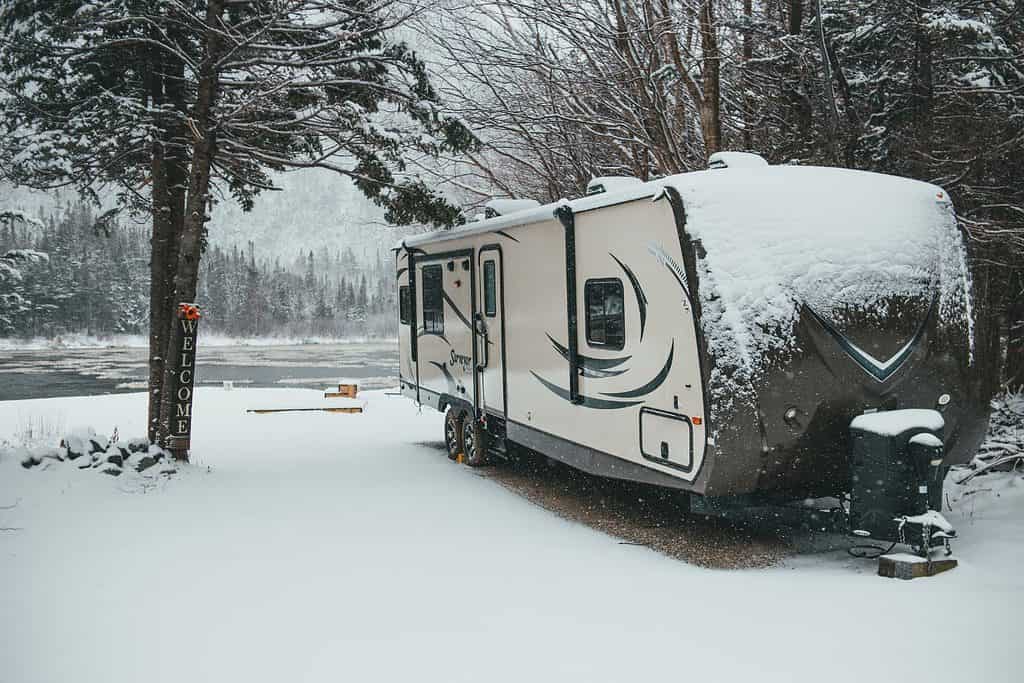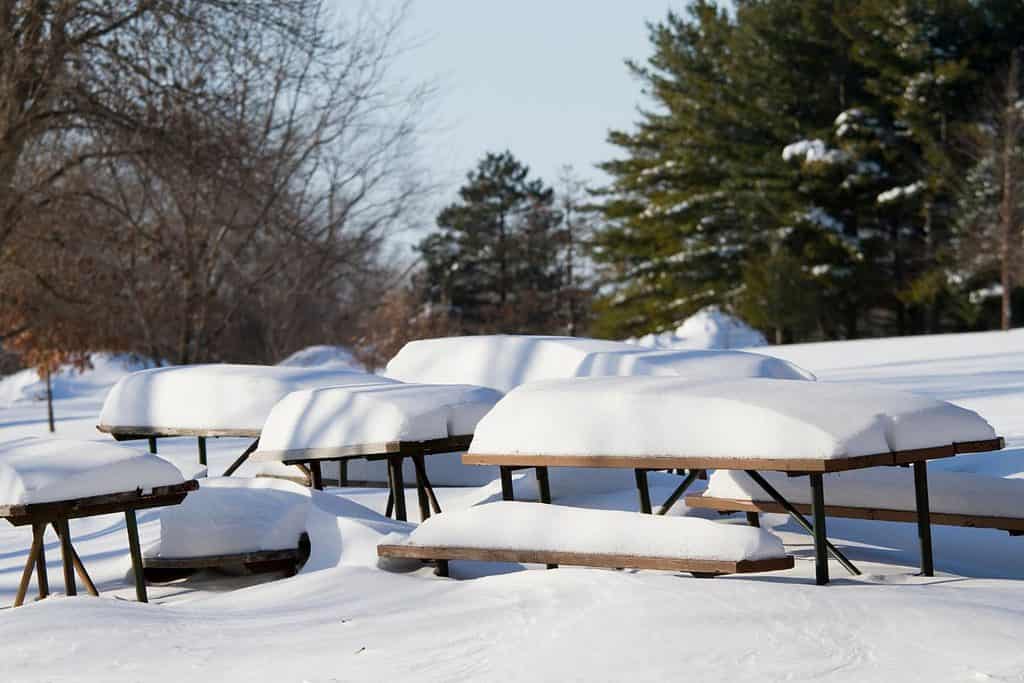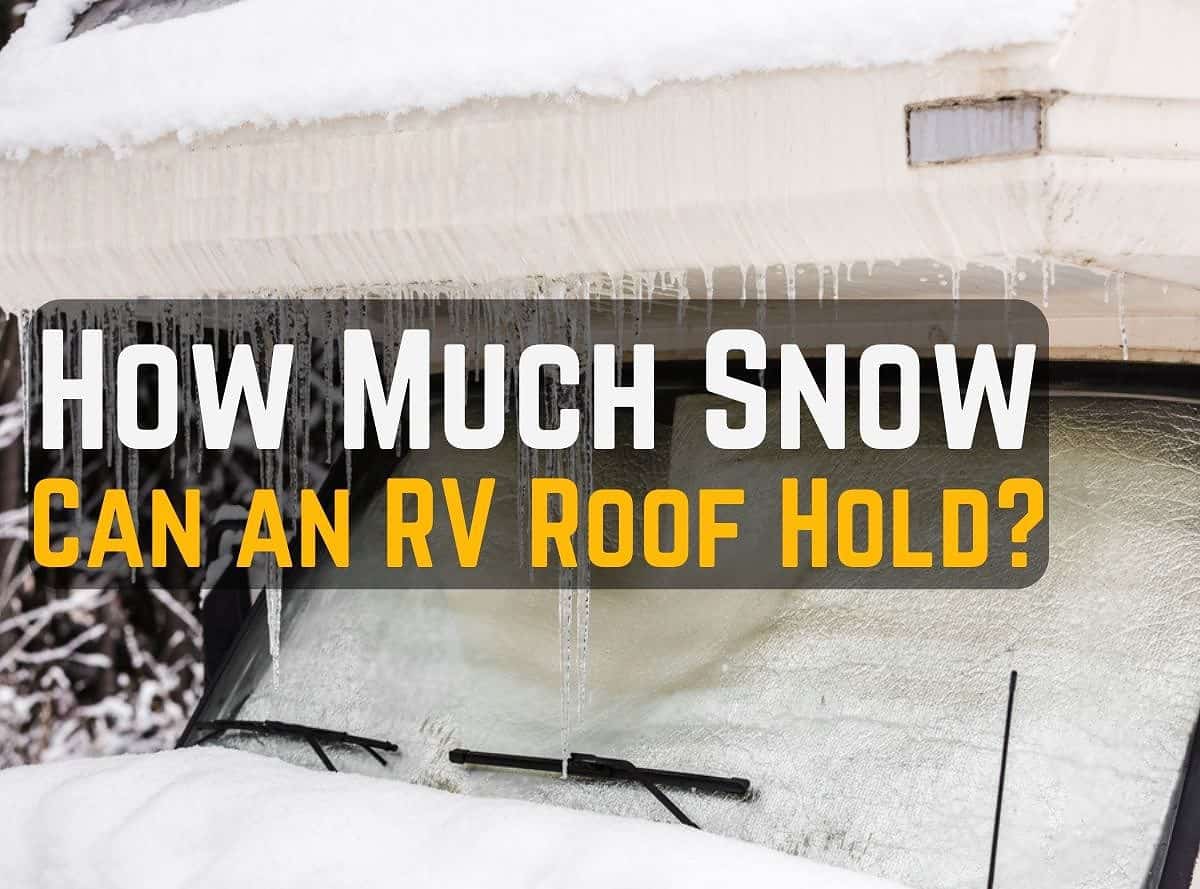How much snow can an RV roof hold? Surprisingly, there’s hardly any advice or documentation on the subject other than from other websites run by other RVers and forum posts from RVers and campers.
To figure this out, we dug in to do some research, some math, and learn more about how much weight RV roofs can hold and how much snow weighs.
In general, your RV or camper roof can safely hold 1-2 feet of snow. Snow can weigh 10-20+ pounds per cubic foot, and most typical roofs are designed to hold 20-30 pounds per square foot. This limit will vary depending on your RV model, year, and condition.
This post may contain affiliate links. This means that if you make a purchase after clicking a link on our site, we may earn a small commission.
Table of Contents
How Much Weight Can an RV Roof Support?
There is no set amount of weight that all RV roofs can support. The actual answer is: it varies. RV roofs are made out of different kinds of materials. And some aren’t really made to support much weight at all.
Most recommendations cap camper roof weight ratings around 200 to 300 pounds maximum. But, that may not be the case for every RV camper.
Most newer RVs are made to support the weight of a person in order to clean the roof and perform routine roof maintenance. However, with older models that may not be the case.
So, how do you find out how much weight your RV roof can support?
How to Find How Much Weight Your RV Roof Can Handle

If your RV or camper trailer has a ladder, you may find your roof weight limit printed right on the ladder. Check the side poles of the ladder and on the underside of each step if it’s not immediately visible.
If the weight limit isn’t posted on or near your ladder, you may need to check your owners manual. Alternatively, you can reach out directly to the manufacturer.
So where do you look if your RV doesn’t have a ladder?
According to the RV expert, Mark Polk,
“If your RV does not have a ladder on the back to access the roof it is probably not designed to be walked on.”
Meaning: if your RV doesn’t have a ladder, the roof may not be strong enough to support your weight. At least not all of your weight concentrated into an area as small as your foot. For these types of RVs, they may be able to hold distributed weight but not concentrated weight.
If there’s a lot of snow coming and your RV roof doesn’t have a ladder, you may want to consider covering the roof with plywood. That way if you do have to walk on it to clear snow, you won’t damage the roof because the plywood will help distribute your weight.
Types of RV Roofs and How Strong They Are

There are many different types of RV roofs and roof framing materials.
The most common exterior roofing materials are:
- Fiberglass
- Aluminum
- Rubber (EDPM and TPO)
The interior of the RV roof construction matters just as much as the exterior. The interior roof construction plays a significant role in how much weight it can handle.
The construction in most older RVs is wood and wood framing.
However, newer RVs are made with aluminum framing and composite materials. These materials are more lightweight than wood yet stronger and more resistant to damage—particularly water damage.
Aluminum RV roofs are very strong and can typically support the weight of an average person – between 250-300 pounds.
‼️ Note: Keep in mind that these weight limits are estimates and may not apply to every RV or camper.
Fiberglass roofs are generally the weakest if they’re not reinforced, and many fiberglass manufacturers recommend not walking on the roof.
Finally, rubber roofs are found on campers with both aluminum and wood interior framing. The weight capacity of these types of roofs is entirely dependent on the age and condition of the camper and the structural support.
Distributed vs Concentrated Weight on a Camper Roof
In almost all instances, if an RV or travel trailer roof is designed to support the weight of a person, it’s rated to do so in a small area.
If you walk on the roof of your 36 foot motorhome and you weigh 175 lbs, your weight is likely concentrated within a small radius.
If you sit or lay down, that 175 lbs of your body weight becomes further distributed over a larger area of your RV roof.
For most RVs, especially larger and newer model year RVs, handling the weight of an average person in a small area is pretty standard.
A dense amount of weight in a concentrated area is more damaging than weight that’s spread out over the entire roof.
And, since snow doesn’t just fall in one area, your RV roof can likely handle a decent amount before it becomes a problem. Let’s look at how much snow actually weighs.
How Much Does Snow Weigh Per Cubic Foot?

A cubic foot is a 1-foot cube—so when talking about snow, it’s a 1 foot square of snow that’s 1 foot deep. The weight of a cubic foot of snow varies depending on the type of snow.
A cubic foot of light, fluffy new snow can weigh as little as 5 pounds.
A cubit foot of more wet or compact snow can weigh 12.5 pounds or more.
Additionally, the longer snow sits and accumulates, the more it can weigh—even if it’s the same depth. It tends to get more compacted over time. This is especially true if it’s melted a little and is still snowing.
Dense, wet snow can weigh much more – even up to 20+ pounds per cubic foot.
How Much Snow Can an RV Roof Hold Safely – On Average?
With the varying weights and types of snow and snow density, your RV or travel trailer roof can hold 1 to 2 feet of snow on average.
You generally do not need to worry about removing less than 1-2 feet of snow from your RV or camper trailer roof unless you know your roof is weak, you have existing leaks, or if you’re about to travel.
You don’t want huge chunks of snowpack flying off the roof of your RV at highway speeds, so be sure to clear the roof if you’ve got a travel day coming up.
How Snow Can Damage Your Camper Roof
Now that we know how much snow can an RV roof hold, let’s dig in to why it’s important to remove it if it’s too much. Snow can damage your camper roof in several ways.
- Snow weight can cause damage
- Ice can cause cracks and fissures in roof material
- Water damage from melting snow
The weight of a massive accumulation of snow can cause stress fractures and cracks over time. It’s not likely to make the roof of your RV totally collapse unless the roof of your RV was damaged or weakened to begin with.
However, it can cause cracks and leaks around seams, appliances, vents, and more.
Ice on your RV roof is difficult to remove. If your RV roof accumulates ice, it may remain until the weather is above freezing. It is not advised to use sharp objects to break or scrape the ice. This can damage your roof. Also, you shouldn’t use ice melt on your RV roof either. This can cause a problem if you need to walk on your RV roof for any reason.
Finally, melting snow can cause a problem for RVs that have any kind of leak, seam damage, or even pinhole punctures.
Melting snow can find its way into even the smallest openings. This can cause a lot of water damage inside your RV.
Should You Shovel Your RV Roof?
You should never use a shovel on your RV roof. Even if you’re being careful, a shovel can easily lead to worse roof damage.
Scraping your RV roof with a shovel or any type of shovel-adjacent device isn’t recommended. Sharp edges can damage your roof material, cause small cracks or cuts, or even damage your roof appliances and vents.
If your RV has less than 2 feet of snow on it and you don’t have travel plans anytime soon, it’s best to just leave the snow alone and let nature take it’s course.
However, if you need to get the snow off for any reason, it’s easiest to do it right after the snowfall. That way the snow will be fluffy and easy to brush off. The longer you wait, the more dense and hard it becomes.
The best way to remove snow accumulation from your RV roof is with a broom or your hands.
⚠️ Always use caution when getting on your RV roof, especially in wet and slippery conditions. In many cases, you may be able to remove the snow from your roof while standing on a ladder, or while on your knees on the roof.
How to Remove Snow From Your RV Roof
If you need to remove the snow from your RV roof, you can use a broom or your hands.
For light, new snow, a broom may work just fine.
However, if the snow is more dense or it’s been there a couple of days, a broom probably won’t cut it.
Here’s a great video showing how to remove snow from your RV roof, and it’s got some great safety tips and considerations.
How to Keep Snow Off The Roof of Your RV
There are several options for keeping snow off the roof of your RV. Here are a few ideas.
- Park under an RV carport.
- If in storage, opt for covered RV storage to protect the roof from snow.
- Remove any snow accumulation with a broom or snow blower before it can harden or turn into ice.
- If in open storage, use an RV cover. This will help prevent water damage.
Just remember—RVs are designed to be used outdoors. This means they can handle the different types of weather, from rain to wind to snow.
If you are living in your RV in the winter, it’s okay to allow snow to pile up on your roof during winter weather. However, if it becomes excessive – like more than a foot or two deep, it’s a good idea to try and remove it to protect your roof.
Related: 5 DIY RV Skirting Ideas for Winter for Any Budget
Wrapping Up
Snow on your RV roof becomes a problem if your RV roof is weakened, if there is more than 2 feet of snow, or if you’ve got a travel day coming up.
Always remember to exercise extreme caution when walking on your RV roof, especially in slippery conditions.
Most RV roofs can safely support between 200-300 pounds of weight. Most snowfall less than 2 feet in depth should be no problem for your RV roof to handle.


